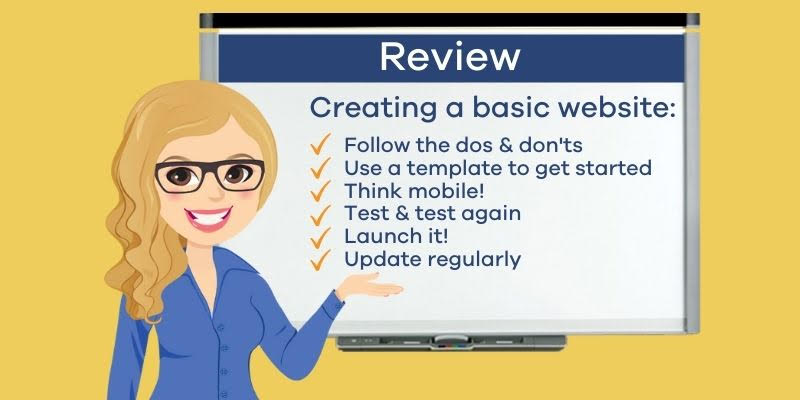Website Basics
Are you putting off building a website for your mobile notary business because it just seems like too much work? If learning to code, sourcing photographs, and figuring out how to create forms sounds overwhelming, we’ve got great news!
You don’t need to know how to do any of that to build a basic website.
The days of needing an expensive designer or web developer to build a simple website are long gone. Today, all you need is an afternoon and (depending on the tools you use) between $20 and $100.
And here is the thing: If you want to build and grow a successful business, a website is a must.
So, in this post, we’ll walk you through everything you need to do to set up a basic website:
Okay, it’s break it all down.

Website Basics – The Do’s:
1. Use A Template
To help build your website, there are lots of paid or free templates out there. Squarespace, WordPress.com, and Wix are some really great website builders and can also host your site too (and you can also buy your domain name from them!) Downloading a free template is a great way to get started, but you may also want to look into hiring a professional web designer if you have more specific needs for your website.
Once you have chosen your template, it’s time to start designing! Choose the colors and fonts that best represent your brand. Think about how the overall design of your website will look, how navigation is laid out, and consider adding images and videos to your pages. Make sure it looks professional and is easy to use so that your visitors can find the information they need quickly.
2. Think About The Navigation
The best place to for your navigation menu is at the top of each page. Is it easy to navigate? Is it easy to contact you? Is it easy to find what you offer? A great sample menu is: HOME | ABOUT | SERVICES | CONTACT
When creating your navigation menu, make sure to keep it concise with clear titles. You don’t want to overwhelm the visitor with too many choices.
Also, use drop down menus so people can find what they are looking for quickly and easily. This way you can have a lot of items listed in the main menu without taking away from the aesthetics.
You can also add a search bar to make it even easier for people to find what they are looking for. Make sure you link all pages, so visitors don’t get lost in your website and abandon it without visiting any other pages.
Finally, if you have a blog or an online store, integrate them into your website navigation. This will make it easy for customers to access the store or blog they are looking for, while giving you more exposure online.
These simple steps can have a big impact on the user experience and create a great flow throughout your website. Don’t forget to test out your navigation menu and all pages before launching your website.
3. Have A Clear Call To Action
Add you phone number and/ or email and always add this info close to the top of the page. If you create a button, make sure it pops with a bright or contrasting color that can’t be easily missed. By having a clear call to action, you make it easy for visitors to take the next step with your business and reach out.
4. Use The Right Fonts
Not all fonts are the same, some are wispy and difficult to read. Bold and simple is best. Best rule of thumb is to use up to 3 fonts – otherwise, it looks unorganized and unprofessional. You should also make sure the font size is appropriate. Too small and it looks unprofessional, too large and it looks like you’re trying to shout out your message. Pick one main font and two complementary fonts for headers and titles, if necessary. Also consider using web-safe fonts (like Arial, Verdana, Georgia etc) as some users may not have the more decorative fonts installed on their computers.
5. Make It Accessible
As mentioned above, make sure the fonts are readable and are no smaller than 16pts in size. White space on a website is okay! Allow for space between each section and avoid cramming everything in. Remember – less is more because people mostly skim and scan websites rather than read (sorry, but it’s true).
Make sure the navigation is easy and intuitive for visitors. Having a menu bar in the header of the website makes it easier for people to find what they’re looking for. Also, make sure that each page has a link back to the home page so your visitors can quickly get back there if needed.
Make sure all images are optimized for the web. This means that the file size needs to be kept as small as possible so it doesn’t take up too much loading time on a website. Make sure any videos are also optimized, and are hosted externally (such as YouTube) rather than directly from your server.
6. Design It For Mobile
Are you reading this blog post on your phone? You’ll notice that the entire Notary Jane website is mobile friendly, that’s because more people view websites on their phones than desktops and tablets. Make sure your website is mobile friendly. All websites should be mobile responsive and look great on any device. This means making sure the design looks good, fonts are readable and that all page elements are easy to click or tap on a touchscreen. This also includes working out how users will navigate from page to page easily, as well as if images and any videos need to load in portrait or landscape mode.
Website Basics – The Don’ts:
1. Use Copyright/Plagiarized Material
This is a BIG no-no and goes without saying. Originality is best. And if you do use material that isn’t yours, please credit the source of where it came from. Websites should showcase your creativity, not someone else’s. You don’t want your website to be taken down or have a lawsuit brought against you. Do not use any copyrighted material on your website without permission from the copyright holder.
2. Adding Too Many Design Elements
Remember to let the eye breathe and that white space is okay, so space out items. Too many logs, images, fonts, and colors can quickly look messy – simple is best
Additionally, try to keep the number of pages, navigation bars and widgets to a minimum. Too many options can be overwhelming for users. If possible, design the website with mobile devices in mind – meaning it is responsive and has features optimized for smaller screens.
3. Have Broken Links
Ever gone to a website and click on a link that doesn’t work? Test your links before and after you publish. We all agree, there’s nothing more frustrating than a dead-end. Similarly, make sure your website is compatible with all browsers; you don’t want to miss any potential visitors! Additionally, don’t forget to check the speed of your website — nobody likes a slow loading page.
4. Spam Your Website With Ads
If you are going for a professional website – then this is a hard “no”. Ads will distract your visitors and take away from the message(s) you are trying to convey. Additionally, if you are just starting out – it’s unlikely anyone would click on your ads anyway and all the ads will ultimately do is slow down the loading time of your website. So save yourself some time, and don’t spam your website with ads.
5. Use Blurry Images
Small image files result in blurry images when displayed on the Internet. People won’t stay to visit a website if it looks low-quality, unprofessional or outdated. Be sure to use quality images that are properly sized for the space they are filling.
6. Spelling/Grammar Mistakes
It’s inenviable (oops) inevitable and it happens but it can be a turn off for visitors. When your website is first launched, share it with a few close friends who are really great at wordsmithing – if what you are trying to say doesn’t make sense to them, it won’t to a potential client. After you’ve made sure that your content is well written, use spellcheck tool to help catch those pesky typos.
7. Optimize
Since you’ve put all the work into building your website, it’s important that people can find it. Make sure to register it with Google My Business. You should also seek out best practices for maximizing SEO potential or even hire someone to fully optimize your site. Additionally, you should research and decide on the best keywords to use for your website.
Are you looking for a company to build your website? Check out Sociable Media.

Lastly, update your website on a regular basis by adding new photos and updating your content. Maybe add seasonal photos to commemorate Fall, Winter, Spring, Summer. Get in the occasional habit of sharing a photo of a signing (with permission of the client(s) and gather testimonials from happy clients (now THAT’s a bonus!)
If you’re an Executive or Premiere Notary Jane member, log into your Notary Jane account and view the Do’s and Don’ts Video which goes into more detail.

